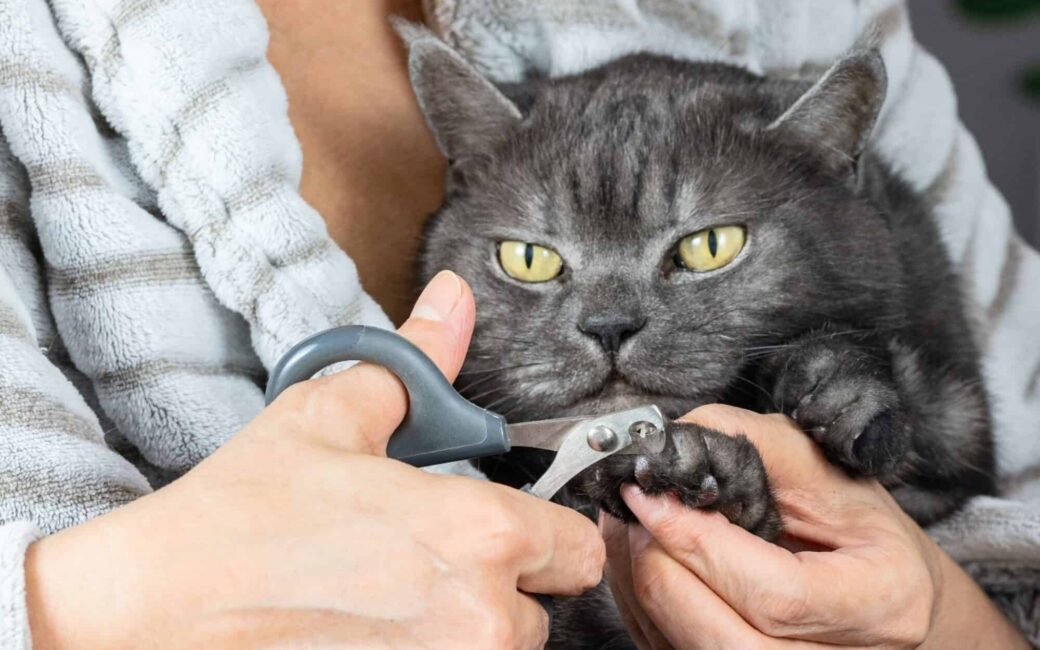Trimming your cat’s claws every few weeks is an important part of keeping your pet well-groomed. It also helps preserve your couch, drapes and other furniture.
Nail-trimming is fast, effective and much more humane than declawing, which involves surgical amputation and can cause behavioral and major health issues.
Unlike a dog, a cat’s claws are retractable. Since they don’t touch the ground when a cat walks, they’re not worn away naturally like a dog’s are. Cats instinctively know they need to sharpen their claws to keep them at a manageable length. Cats that spend part of their time outdoors need sharp claws to climb trees or otherwise defend themselves against other animals. They will usually sharpen their claws on trees and other natural objects. However, indoor cats have no need for sharp claws, but still have this urge to scratch.
With our own indoor ninja cat named Solo, we cut his nails every two weeks (I set my phone to remind me) in order to preserve our furniture while he navigates through his crazy kitten phase in his first year. Meanwhile, we are teaching him where he should and shouldn’t exercise his scratching urges by redirecting him to various scratching posts.
If the idea of trimming your cat’s nails still has you biting your own, rest assured that all it takes is some patience and a bit of practice to sharpen your skills.
Now, let’s get started. In this article, we will go over the tools and techniques for a successful manicure for your favorite feline.
- What to Use: There are plenty of tools available to trim a cat’s claws; use the one that works best for you and your pet. Dogs require special nail clippers, but cats don’t. Some people prefer a special pair of scissors modified to hold a cat’s claw in place, but I personally prefer regular human nail clippers. Why? Well, as I mentioned before, I have a ninja cat on my hands and I need to be fast and confident when I’m trimming his nails. Few cats will remain patient for the time it takes to cut all his nails, so you don’t want to waste valuable time fumbling around with clippers you’re not used to. Whatever your tool, be sure the blade remains sharp; the blunt pressure from dull blades may hurt an animal and cause a nail to split or bleed.
- Setting the Mood: Choose a quiet place to avoid scaring the pet. Because cats’ temperaments and dispositions vary greatly, there is no “perfect” way to handle a cat while trimming their claws. Some cats do well with no restraint at all, but most cats need to be held firmly but gently against your body to make sure that no one gets hurt. Choose a chair or sit on the floor in a quiet room where you can hold your cat comfortably in the crook of your arm or on your lap. Wrapping your cat gently in a towel can give your cat a sense of security and helps hold her still while you work. Make sure no other pets are around and try to get her when she’s relaxed or sleepy, like in her groggy, after-meal state. If you have a helper, now’s their time to shine. They can assist by holding the cat while you clip, or maybe just distracting her with some head scratching, a toy or a favorite treat.
- Cut to the Chase, But Not to the Quick: Start by pressing down gently on the paw. This will extend the claws outward. Clip only the sharp tip no more than 1/8 of an inch of the white or transparent tip of the nail. Make sure not to cut the pink part of the nail, also known as the quick, as this is where blood vessels and nerve endings begin. This is just like the pink part of your own fingernails, and if you cut into that area it will cause bleeding and pain. If you should accidentally nip the nail too short and bleeding starts, apply a little pressure to the very tip of the claw. Don’t squeeze the whole paw, as that will increase the bleeding. To stop the bleeding, dip the claw in a little styptic powder or cornstarch, or rub the nail across a dry bar of soap. At this point, you should leave the rest of the nails for another day, but keep an eye out to make sure the bleeding stops quickly. It’s usually not necessary to cut the rear claws, but check them occasionally, and if they appear excessively long or are starting to curve inward, they should also be trimmed. Cats are usually less tolerant of having their rear claws clipped, so this may take a few attempts.
TO SUM IT UP:
- Nail Cutting: Cats have a natural desire to sharpen their claws. To keep them from destroying your furniture while satisfying this urge, it’s important to begin cutting your cat’s nails every two weeks, if possible. Developing a routine of regular nail cutting will allow your cat and your couch to co-exist peacefully.
- Scratching Posts: It’s also recommended that you provide a few various scratching posts (vertical and horizontal) that allow your cat to stretch out and sharpen his claws – catnip on and around the post is an added incentive.
- Declawing: Remember that declawing is cruel and unnecessary and should never be considered. For humane solutions, click here
For more info on ways to distract your cat from clawing, click here

